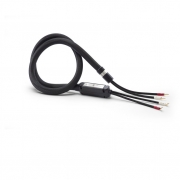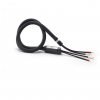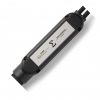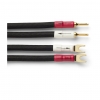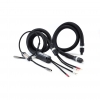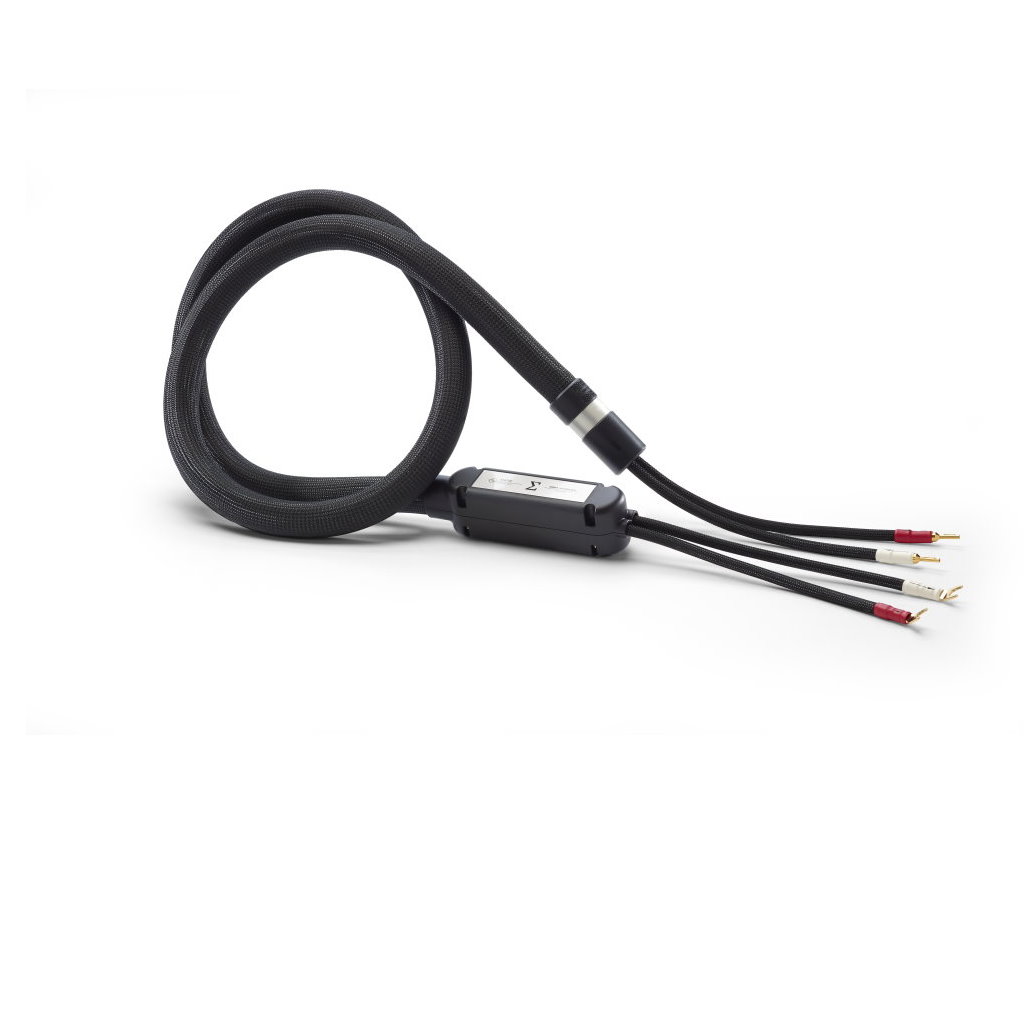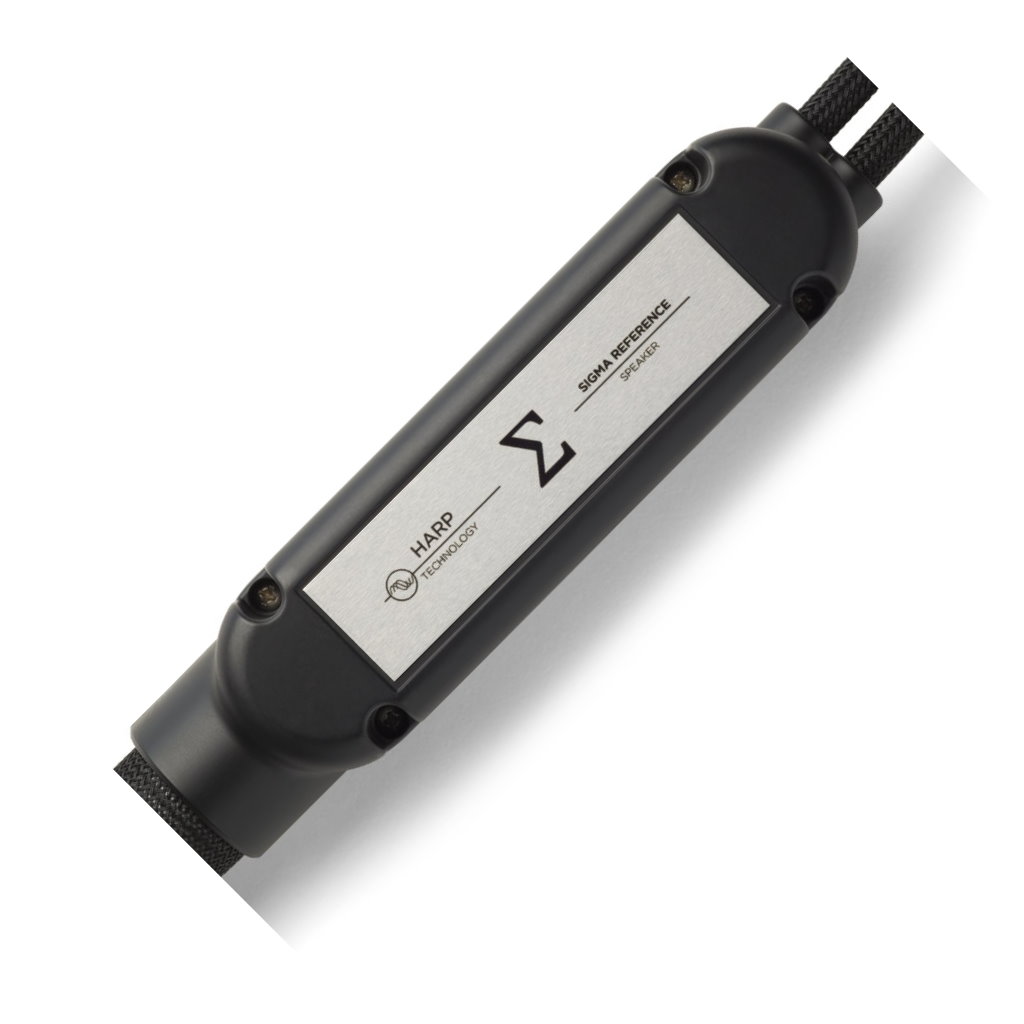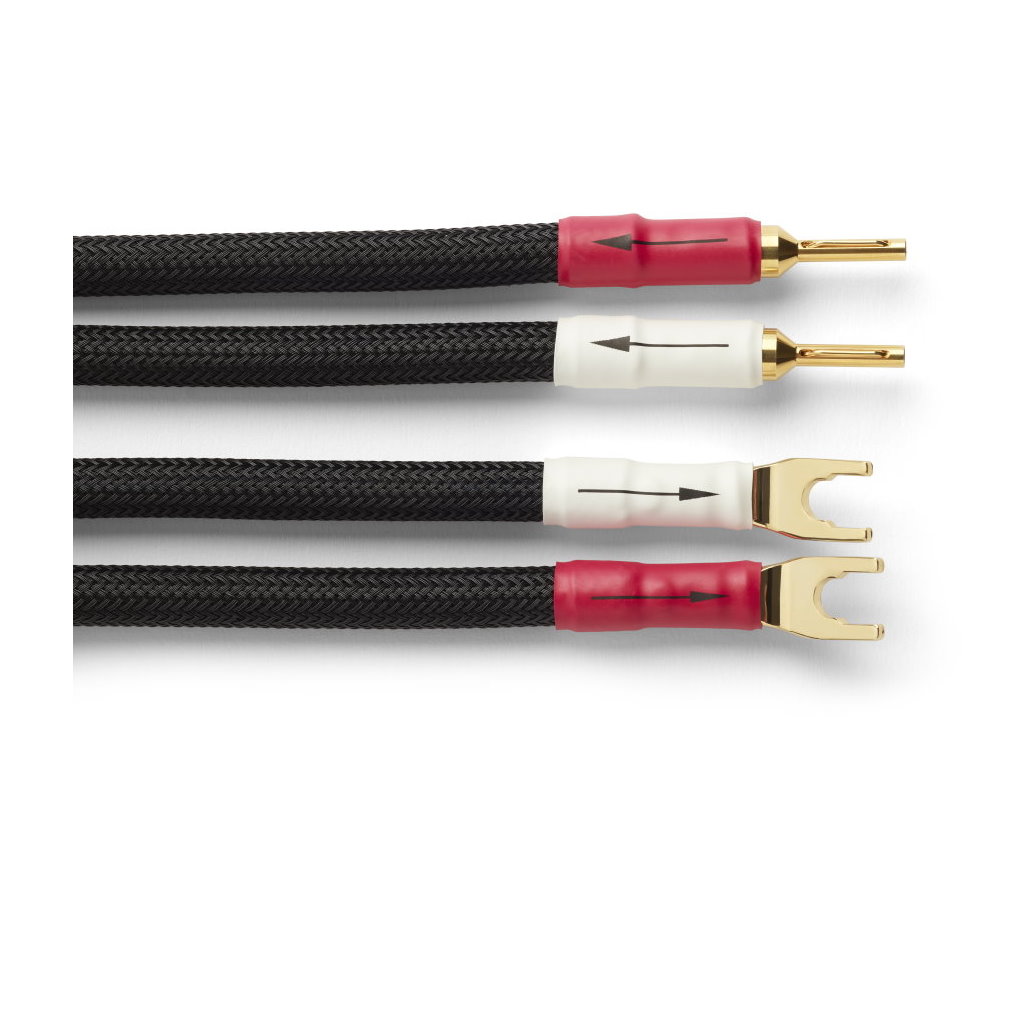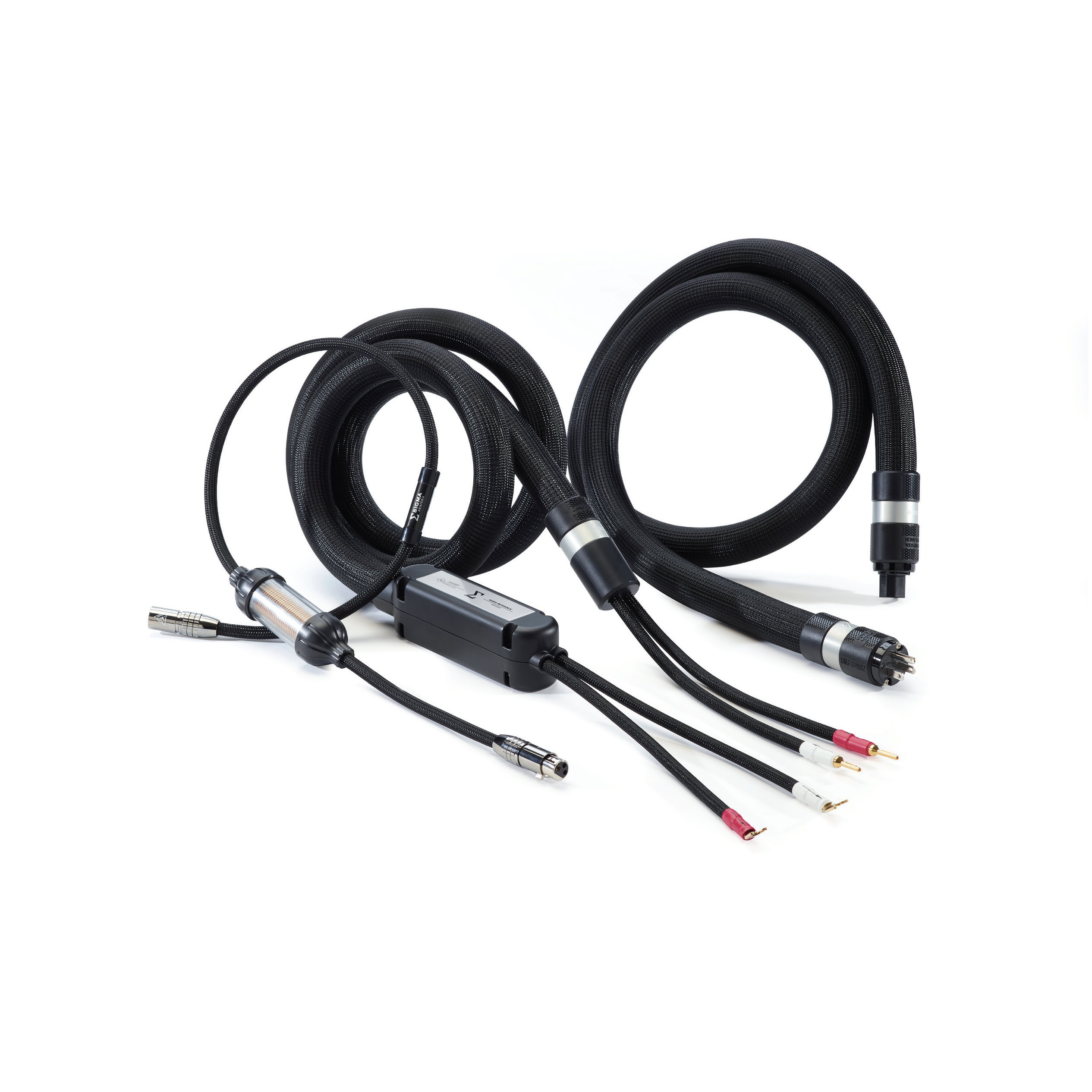- AUDIO ONE-TO-ONE Call Now: 210-805-9927
- Contact
- Register
- My Account
Shunyata Sigma Series Speaker Cables
Shunyata Sigma Series Speaker Cables
Shunyata Sigma Series Speaker Cables
Description
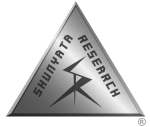
MY TAKE: Simply put, Shunyata Sigma cables are the best performing cable products I have ever experienced. They offer an other-worldy level of performance that is truly extraordinary. Whether it be the Sigma power cables, interconnects, speaker cables or digital links, Sigma products can elevate even the best systems to new levels of resolution and musical involvement. For those with the means, I can't recommend a product more strongly. - Galen Carol
“Now we come to the inevitable question: how do the Sigmas sound? The simple answer is that they sound like nothing I’ve ever heard -- nothing at all, in my experience.
“… they remove a barrier between you and the utterly visceral, thrilling experience that is live music.” – Vance Hiner, The Audio BeatAs the performance vanguard in the Shunyata Research cable line-up, SIGMA SERIES cables take the term state-of-the-art to an entirely new level with the introduction of two new cutting-edge technologies.
Sigma Series interconnects include the Transverse Axial Polarizer (TAP) that minimizes a form of micro-distortion identified as electromagnetic polarization. The Sigma Series speaker cables incorporate a proprietary device called HARP that reduces current resonances within the cable, a concept that is somewhat analogous to diffraction in room acoustics. ~ Patents Pending ~Sigma – A Convergence of Science and Art -
Sigma Series cables showcase technological innovation and design execution that simply does not exist elsewhere — at any price. Sigma Series cables combine meaningful parts innovations with objective measurement and an artisan’s eye for construction quality. Unlike many cost-no-object cable products that have little in the way of discernible science, Sigma Series products incorporate an array of definable technologies that sets the standard for quality and performance in the cable industry.
Speaker Cables
Next to power cables, speaker cables are the most critical signal cable links in an entertainment system. This is because speaker cables must transfer the delicate music signal while also conducting very high current into a speaker that presents a dramatically varying low-impedance load. Shunyata has spared no expense in the design of its speaker cables’ ability to deliver high current while eliminating the multiple forms of micro-distortion that would otherwise obscure and distort the original music signal. Shunyata Research speaker cables start with ultra-pure OFE copper in a VTXTM ‘hollow tube’ geometry that maximizes power transfer while minimizing skin effect.
As you go up the series ladder, more advanced technologies become available, including; patented ΞTRON® that eliminates dielectric distortion and HARP technology that reduces current resonance modal distortions. Shunyata Research uses a costly sonic welding process that bonds metals at a molecular level without the use of solder, brazing rods or any other intermediary metals. This process is superior to crimping, soldering, cold soldering and cold welding. There is no better method to join conductors to terminals, which ensures maximum power transfer and a distortion free termination. The result of these accumulated technologies is distortion-free performance rarely experienced, regardless of cost.Sigma Speaker Cables -
Shunyata Research’s Sigma Series is quite simply our highest performing speaker cable. Exclusive HARP technology reduces current resonances with the cable. KPIPTM eliminates burn-in issues.
Shunyata Technology – Cable ProductsHighest Purity Copper -
Shunyata Research uses only the highest purity of copper available for the production of its wire products. OFE Alloy 101 or C10100 is the highest grade of copper with a minimum 99.99% purity and a conductivity rating of 101% IACS. OFE stands for oxygen-free electrolytic and supersedes the term OFHC (oxygen-free high conductivity). C10100 is the only grade of copper that comes with a written certification of purity. Certified by ASTM F68 C10100.Single Crystal Technology -
Ohno wire, also called PCOCC was invented in 1986 by professor Atsumi Ohno of the Chiba Institute of Technology in Japan. Copper wire is created by an extrusion process that pulls a rod of cold copper through a small orifice which creates multiple crystalline boundaries. By contrast, Ohno wire is made by a process using heated molds that cast a wire to form a single crystalline structure. Ohno wire is well known for its exceptionally pure, grain-free sonic qualities.VTX Conductor Design -
Shunyata Research’s exclusive VTXTM conductors are made in the shape of hollow tubes. Since current can ‘only’ travel through the outer rim on the wire, there are no skin effects or random eddy currents. VTXTM conductors are made from pure OFE C10100 or Ohno (single crystal) copper.KPIP Conditioning -
KPIPTM (Kinetic Phase Inversion Process) was developed by Caelin Gabriel after years of research into the underlying causes of various effects such as burn-in, wire directionality and the effects of cryogentic treatment. He discovered that there was an underlying core principle that burn-in and cryogenics only “partially” addressed. Once the governing principle was understood it became possible to create a processing technique and machine that could virtually eliminate the need for burn-in and cryogenic treatment.Unique Conductor -
ArNi® is a type of wire created by Shunyata Research designed to be the finest quality wire available for audio purposes. It begins with the highest purity of copper available – OFE C0100 or Ohno (single crystal). Then it is formed in virtual hollow tubes eliminating skin effects and eddy current distortions. In addition, the wire undergoes our proprietary KPIPTM process.Patented ΞTRON® -
ΞTRON® is a technology developed by Shunyata Research that prevents dielectric absorption and re-radiation in signal transmission. It requires a special type of conductor that has two signal paths and an electric field compensation circuit that creates a cancellation signal that prevents the insulation from developing a charge. ΞTRON® cables preserve the integrity of the source signal even when using very long runs of cable. Patent US 8,912,436, Patent Ch ZL201180047344.2.Custom Connectors -
Many audiophile grade connectors are made from brass or bronze. While some may get a plating of silver, gold or rhodium, the majority of the current is carried by the contact’s base-metal. CopperCONN® connectors contain pure copper contacts which has a much higher conductivity that brass. The difference in performance is clearly audible.TAP -
TAP (Transverse Axial Polarizer) is a device that interacts with the electromagnetic field generated by the signal traveling along the signal cable. TAP improves the sonic performance of the cable by modifying the behavior of the electromagnetic wave that surrounds the signal cable. In effect, the TAP blocks longitudinal-oriented waves while passing transverse oriented waves. The effect in sonic terms is like using polarized sunglasses to reduce reflected sunlight. Correcting polarization micro-distortion reduces what some call sonic glare. ~ Patent Pending ~Precision Matching -
Shunyata Research digital cables are produced using a Precision Matched Z (PMZ) concept. This means that tolerances of the conductor surface, dielectric extrusion, and the precision of the braided shield are held to minute variances. To achieve these tight tolerances, the extrusion and braiding machines must be run at one-quarter speed during the manufacturing process. The result is better performance through a reduction of cable-induced ‘signal jitter’. (Note: Z means impedance)PMZ) concept. This means that tolerances of the conductor surface, dielectric extrusion, and the precision of the braided shield are held to minute variances. To achieve these tight tolerances, the extrusion and braiding machines must be run at one-quarter speed during the manufacturing process. The result is better performance through a reduction of cable-induced ‘signal jitter’. (Note: Z means impedance)Superior Termination Techniques -
Crimping, soldering, brazing and cold soldering are all inferior methods of joining two wires or terminals together. Sonic welding uses high energy sonic waves to literally join two metals together at a molecular level. There is no solder or intermediary metals involved in the process.HARP -
HARP was discovered through Gabriel’s research into ‘current drift’ and audio frequency current resonances that occur in speaker cables. Theoretically, a speaker cable may develop current resonances in the audio band, being roughly analogous to standing waves (modals) in room acoustics. The HARP module acts as a current mode diffraction device that breaks up these resonances, improving the perceived resolution and coherency of the system.
REVIEWS:The Audio Beat: "I used the Sigma v2 interconnects and speaker cables for an extended period of time and with a diverse collection of über-fi electronics and speakers. These included tube, hybrid and solid-state electronics, fixed-baffle and time-adjustable speakers, with and without subwoofers, and multiple digital and analog sources. Due to the system I had at the time we initially discussed this review, Shunyata sent me multiple pairs of interconnects and speaker cables, along with power cords and even digital cables -- enough wire to go from wall to speakers. Or in the case of that initial system, from wall to speakers and subwoofers: Wilson XVXes and Subsonics. This meant four channels of amplification, multiple digital and analog sources, and an inline crossover. Initially, I used all XLR-terminated interconnects, but when electronics arrived from Convergent Audio Technology, I switched to all single-ended, being sure to allow for ample break-in time. Then the CAT electronics were replaced with something completely different: CH Precision's P10 preamp and M10 amps. Back to XLR cables, and when the Wilson speakers and subs were packed up, replaced with a pair of Stenheim Ultime 3 speakers, which sound best biwired and biamped, the extra speaker cables still came in handy, although I was then short of 20-amp-capable power cords for the CH Precision amps. Shunyata to the rescue with enough power cords to again wire up the system from stem to stern.
"I mention all of this because no matter the electronics and speakers in use, no matter the source material, the Sigma v2 interconnects and speaker cables were consistent in terms of their contributions to the system's sound. Considering all of the component and cable swapping I describe above, I must have inserted or removed a Shunyata Sigma v2 cable at least fifty times. I started over from scratch a half-dozen times. Throughout all of this, the sound of the Sigma v2 cables was distinct and all-encompassing. As I came to understand, it was defined as much by what I didn't hear as by what I did. By that I mean that Sigma v2 was by no small measure the most poised audio cables I've used. There was an eerie blackness from which each instrument or singer emerged. They were utterly pure, composed, neutral conduits of the music, allowing it to flow with natural pacing and dynamics along with full-color tonality. They also expertly conveyed the spatial information and recording cues of each recording, the things that define the sonic thumbprint.
"The Sigma v2 cables were sonically invisible in the very best sense, displaying the inherent nature of the equipment and presenting the music with an obvious sense of calm and quietude. Some cables, even those that are considered to be in the first rank, overlay the music with their own personality, which may be significant or minor in effect. Not the Sigma v2 cables, which were like air or water -- a neutral substrate for whatever equipment they connected and the signal passing through them. And because they were the one constant with all of the equipment I mention, they were as responsible for the sound produced (and described in my reviews) as the products themselves.
"In specific terms, what this translated to, first and foremost, was an obvious sense of speed, spaciousness and snap, a kind of physicality that was not about added tonal density or image fullness, for instance. The music was fast and present, with recordings as diverse as Suzanne Vega's Close-Up Series CDs [Amanuensis 2507] and the mono LP reissue of Kenny Dorham's classic Quiet Kenny [New Jazz/Craft Recordings CR00347] having much the same high energy and color, even though they are very different recordings. This doesn't mean the Sigma v2 cables homogenized recordings, pulling the inherent sound of one toward that of the other, but rather that they unleashed it, displaying all that both recordings have on offer, opening up sonic avenues that are easy to gloss over. The Sigma v2 cables possess true tonal neutrality, without the overlay of whitish scrim that some other "neutral" cables can impart. Tonal color is conveyed but not enhanced, the cables' inherent honesty, in all sonic ways, allowing each recording to proclaim its sonic signature.
"Percussive force -- snappy transients, weighty bass with pitch definition and dynamics -- was very obvious with the Sigma v2 cables in use. Some of my favorite recordings, like "Day to Day Thing" from the Neville Brothers Family Groove [A&M AA7502153842], had sternum-crushing force when played at 11. The Neville Brothers also do a pretty good cover of "Fly Like An Eagle" on this album, and it highlighted the Sigma v2 cables' way with soundstaging, which was wall-to-wall wide and also deep and dark, as shown with Quiet Kenny and several other jazz recordings, mono or stereo, of the same vintage. Again, all of this wasn't a matter of giving favors to certain recordings; the Sigma v2 interconnects and speaker cables are too honest for that. Listen to a compressed recording, spatially and dynamically, and you'll know it. The cover of Prince's "Raspberry Beret," from the Hindu Love Gods CD [Giant 7599244062], which pairs Warren Zevon with three-fourths of REM, sounds hashy and dreary, as it always has. Great music, blah (at best) sound, unfortunately.
"As I took notes about what I was hearing, I kept coming back to the "purity," the "tonal rightness," of the Sigma v2 cables, and "the effortless way the music flowed" with them in the system. A decade ago, it was easy to find great LPs for a quarter or less each at the many thrift stores in the mid-sized town in which I live. Now the same is possible with CDs, and one gem I found a year ago is the DCC gold two-disc set of Ella Fitzgerald Sings the Cole Porter Song Book [Verve/DCC GZS-(2) 1079/1 &2]. Fitzgerald's enunciation and swing are wonderful on this recording, and beyond wonderful with the Shunyata cables in the system.
"As I listened to these recordings through many system changes, I tried to imagine some way to describe what the Shunyata Cables bring to an audio system in quantifiable terms. Caelin Gabriel is all about quantifying, and in that spirit, the best I could come up with, after much thought, was a recording whose sound summarizes, at least for me, what I heard from the Sigma v2 cables. Patricia Barber's Café Blue has become an audiophile warhorse; I have several different copies of it, on CD, SACD and LP. Each is a sonic wonder, hence its popularity among audiophiles. The sound obscures some entertaining and inventive jazz, but it also makes Café Blue that much more powerful. I play it for non-audiophiles, who immediately understand that what they are hearing is sonically superior. In any case, it you know the sound of Café Blue, you will understand and appreciate the delicacy, punch, vividness, atmosphere, beauty and truth that Sigma v2 brings to an audio system. It's all there, in Café Blue and Sigma v2.
"Before I end, I want to address one of Shunyata Research's defining principles that gets little or no coverage: how the company prices its products, especially the Sigma v2 cables. They reside at the top of the company's price structure, but based on the actual cost, not a guess as to what the market will bear or as a proclamation of prestige or status. While Sigma v2 cables are surely not budget priced, they are far, far from the current top of the pricing heap for audio cables. While Shunyata could simply inflate the price, the company refuses to do so, instead basing its pricing on the cost of materials and manufacturing, with reasonable profit on top of that. As has become more the fashion in high-end audio, price equals sonic worth in the minds of some audiophiles, perhaps too many audiophiles, putting Sigma v2 at a perceptual disadvantage. They're surely too inexpensive to compete with the platinum-priced offerings from other companies, so the thinking goes, and therefore don't belong a system costing as much as a luxury house, or two even. Nonsense. I used Sigma v2 with some of the best and priciest speakers and electronics currently available, and you've now read what I heard. Perceptual disadvantage? Only in the eye, not the ear, of a particular kind of beholder.
"I don't know if the Caelin Gabriel of 1998 had some idea of where he and his fledgling company would be after a quarter of a century, but I have to think he would have been very pleased with the long roster of successful products and patented technologies he has created. Shunyata's power products have overshadowed the company's "signal cables," but Sigma v2 should change all that. They are reference-grade cables with nothing near reference-grade prices. If some audiophiles consider that a sign of compromise, they will be missing out on one of the great cables here and now. As much as any product I've reviewed, Sigma v2 urges the sage advice, Hear 'em before you buy anything else." - Marc Mickelson
Read the full review here
The Audio Beat 2021 review of the V1 Sigma cables: “In the world of high-end audio, cable brands are a bit like religious denominations. Each has its adherents and detractors. Some people use cables as tone controls, some apply them like Band-Aids, and others are looking for a way to eliminate their influence completely. After years of experimentation, I have found myself attracted to that last camp, even though I know it’s hopelessly idealistic. The best cable is no cable sounds good on paper, but there will always be a transmission method and that method is bound to have an impact on the final sound. Even our own ears color what we hear. So, a more achievable goal would be to find a method of transmitting electronic signals that has the least possible effect on those signals.
“Effect reduction, as I'll call it, is one of the reasons I’ve used Shunyata interconnects and speaker cables in various iterations for almost a decade. My previous reference wires were selected for their warm character, something I thought I needed for the relentlessly analytical solid-state front-end and unforgiving speakers I had at the time. Once my reference system improved a couple of notches, I began looking for cables that would begin to match the transparency of the better components. Shunyata’s Python speaker cables and interconnects were just the ticket. From there, I graduated to the company’s Zi-Tron Python cables and most recently to its Zi-Tron Anaconda models. In the process, I became a believer in the "full loom" concept of cable upgrades after several less-than-successful attempts at mixing and matching brands.
“It has been six years since Shunyata unveiled its Zi-Tron lines, and a lot has been going on in company founder Caelin Gabriel’s Poulsbo, Washington, laboratory. In addition to incorporating innovations from its power products, several brand-new patent-pending technologies have been added to the latest flagship -- the Sigma Series cables.
“First, these new interconnects, speaker cables and digital cables all use Shunyata’s VTX conductors, which first appeared in the company’s best Zi-Tron power cords and are made in the form of virtual hollow tubes. Shunyata says these conductors eliminate random eddy currents and skin effects that can cause signal distortion.
“While the Sigma cables continue to be based upon Shunyata’s patented Zi-Tron circuit, which the company says "prevents dialectric absorption in signal transmission," they’ve also upgraded the speaker cables with the world’s latest and highest-grade oxygen-free electrolytic copper alloy, known as OFE Alloy 101. Further, all Sigma interconnects are made with the Ohno continuous-cast process, which does not rely on common extrusion, but instead utilizes Japanese inventor Atsumi Ohno’s method of using heated molds to cast the copper into a single crystalline structure. Shunyata believes this method results in sound that is especially pure and grain-free.
“All Sigma cables also go through the company’s proprietary Kinetic Phase Inversion Process (KPIP), which eliminates the break-in process typical of many high-end cables. Shunyata founder Caelin Gabriel is particularly proud of this breakthrough and says that cables treated with KPIP are far more transparent, stable and free of distortion than cables that are broken in by traditional playback or other burn-in technologies, regardless of how long those methods have been applied.
“In addition to all of these innovations, Shunyata introduces in the Sigma line three new technologies. The first involves the elimination of soldering from its speaker cables, which has been replaced by a highly specialized sonic welding process that bonds metals together at the molecular level. One sonic welding unit costs in excess of $60,000 and all Shunyata’s techs must go through an extensive training process in order to use the devices. The result, according to Gabriel, is that the sonic signature of solder is entirely eliminated. Those who are skeptical must bear in mind that equipment designers from every field of high-end audio agree that the type of solder used can have a profound impact on a component’s sound, so no solder at all should be a clear advancement.
“Each Sigma analog interconnect and digital cable sports a Transverse Axial Polarizer (TAP), which looks a bit like the barrel of a ray gun. A gold-plated copper honeycomb disc is encased in a glass tube positioned on each cable near the upstream connection. According to Shunyata, the patent-pending TAP device modifies the electromagnetic wave field that surrounds a signal cable. Gabriel compares the TAP’s sonic effect to how a good pair of polarized sunglasses alters sunlight; by correcting wave polarization, the TAP reduces what might best be described as sonic glare by altering the angle of the electromagnetic and inductive interaction with the signal.
“Finally, the Sigma speaker cables are equipped with another patent-pending technology called HARP. Gabriel came up with the idea for this invention while researching current drift and current resonances that occur in speaker cables. The HARP technology is contained in a rectangular module located just prior to each speaker connection and works to diffract current modes, not unlike acoustic treatments used to diffract standing waves (modals) in a listening room. Gabriel says the result is a cable that has greater coherency and is more revealing of the fine detail that can otherwise be obscured by current resonances.
“Now we come to the inevitable question: how do the Sigmas sound? The simple answer is that they sound like nothing I’ve ever heard -- nothing at all, in my experience. The more complicated answer brings me dangerously close to new-age philosophy, where metaphysics overruns good sense. If I tell you they sound like no cables, you have every right to smirk and ask me, "Well, what does that sound like?" The best I can do is offer an analogy and then some specifics.
“Imagine for a moment that you’ve lived your life wearing surgical gloves. You’ve certainly been able to distinguish and appreciate a great deal of the objects you touch, but once the gloves are off, you discover just how much you’ve been missing. The surface of an apple looked smooth before, but then you discover that it really isn’t. Ice was cold, but nothing prepared you for just how wet and cold it is against your skin. In fact, you’re amazed to learn that ice can actually burn. This is what the Sigmas do: they remove a barrier between you and the utterly visceral, thrilling experience that is live music.
“So, what is all of this transparency worth? While an entire loom of Sigma cables would cost more than some people’s entire systems, their price point is decidedly lower than what most competing companies are charging for their flagship wires. Still, even the folks at Shunyata are quick to point out that no one should spend this kind of money on interconnects instead of purchasing decent speakers and source equipment. They also say that their Alpha and Delta lines deliver a significant portion of the Sigma's performance for considerably less money. I’m not qualified to offer financial advice, but my experience with the Sigmas proves to me that they can elevate the performance of a very refined system to a level that equals similarly priced components I’ve auditioned. If you are pleased with your current rig and want to see just how high it can fly, auditioning the Sigmas would be a good place to start.
“Toward the end of my listening, I wrote that the Shunyata Sigmas "open up an unrestricted channel in the signal chain, allowing my speakers to breathe in full, deep breaths of each recording." When it comes to music, it’s often a combination of many small, yet true-to-life elements that can culminate in a performance’s most magical moments. Shunyata’s Zi-Tron Sigma speaker cables, interconnects and digital cables did a remarkable job of revealing those moments from every source and format.” – Vance Hiner
Read the full review here
Absolute Sound: ""Shunyata has developed some fantastic new signal cables. Sigma carries over some features from previous designs: OCC OFE101-grade copper conductors, a virtual hollow tube wire configuration (VTX), and a passive circuit (ZiTron) that cancels out an electromagnetic field that can build up in the dielectric. Sigma adds the following, mostly proprietary new features: Kinetic Phase Inversion Process (KPIP), a treatment that essentially eliminates the need for break-in and determines a cable’s optimal signal direction, sonic welding to eliminate distortion-inducing solder; a Transverse Axial Polarizer (TAP) unit on the interconnect to filter out glare-causing longitudinal electromagnetic waves; and HARP, a unit on the speaker cable to reduce what is known in physics as “current drift.” HARP, in particular, is remarkably effective at improving overall system performance. Build-quality is excellent as is sonic performance, allowing the deployed system to sound highly resolving of fine details with a large open soundstage and focused images. Dynamic precision, overall coherence, and natural timbre are also strong points. Sigma reduces noise, glare, and apparent time smear to levels that allow more of music’s appeal to come through better than with any similarly priced cables I know of—and by a shockingly wide margin"
"Shunyata Research has outdone itself with these new Sigma signal cables. No aspect of their performance represented a “worthy compromise” or a retrenchment of one set of sonic attributes to advance a set of others. The Sigmas are flat out fabulous across the key areas of dynamic fluidity and stability, soundstaging and imaging, resolution of detail, tonal complexity, and musical completeness. If you are in the market for cables in their price category—or even substantially higher—the Sigmas should be on your audition short list. Enthusiastically recommended".- Kirk Midtskog
Full Review Here
"I was able to bring a complete set of Sigma cables to my friend Lou’s house to find out if they worked as well in his system as they did in mine. The answer was yes—an unambiguous, overwhelming, yes. Within an hour or two of settling time, the Sigmas helped Lou’s system—an already really nice one—sound more lifelike. The replaced Kimber KS1136 ($3335 1m XLR) interconnect and Cardas Clear Beyond ($8170 2m) speaker cable are a good fit for this system, but the Sigmas allowed it to sound much better in every way. All music sounded more alive, more detailed, more dynamically nimble. Imaging was more focused, and the overall soundstage enlarged with a similarly improved depth layering I heard in my system. The same reduction in glare and underlying electronic noise I heard in my system I also heard in Lou’s. The qualitiy of sounding more organized as well as more vivid followed the Sigmas in both systems." - Kirk Midtskog
Absolute Sound - Cable Product of the Year 2018

Shunyata Sigma Series Speaker Cables
Description

MY TAKE: Simply put, Shunyata Sigma cables are the best performing cable products I have ever experienced. They offer an other-worldy level of performance that is truly extraordinary. Whether it be the Sigma power cables, interconnects, speaker cables or digital links, Sigma products can elevate even the best systems to new levels of resolution and musical involvement. For those with the means, I can't recommend a product more strongly. - Galen Carol
“Now we come to the inevitable question: how do the Sigmas sound? The simple answer is that they sound like nothing I’ve ever heard -- nothing at all, in my experience.
“… they remove a barrier between you and the utterly visceral, thrilling experience that is live music.” – Vance Hiner, The Audio Beat
As the performance vanguard in the Shunyata Research cable line-up, SIGMA SERIES cables take the term state-of-the-art to an entirely new level with the introduction of two new cutting-edge technologies.
Sigma Series interconnects include the Transverse Axial Polarizer (TAP) that minimizes a form of micro-distortion identified as electromagnetic polarization. The Sigma Series speaker cables incorporate a proprietary device called HARP that reduces current resonances within the cable, a concept that is somewhat analogous to diffraction in room acoustics. ~ Patents Pending ~
Sigma – A Convergence of Science and Art -
Sigma Series cables showcase technological innovation and design execution that simply does not exist elsewhere — at any price. Sigma Series cables combine meaningful parts innovations with objective measurement and an artisan’s eye for construction quality. Unlike many cost-no-object cable products that have little in the way of discernible science, Sigma Series products incorporate an array of definable technologies that sets the standard for quality and performance in the cable industry.
Speaker Cables
Next to power cables, speaker cables are the most critical signal cable links in an entertainment system. This is because speaker cables must transfer the delicate music signal while also conducting very high current into a speaker that presents a dramatically varying low-impedance load. Shunyata has spared no expense in the design of its speaker cables’ ability to deliver high current while eliminating the multiple forms of micro-distortion that would otherwise obscure and distort the original music signal. Shunyata Research speaker cables start with ultra-pure OFE copper in a VTXTM ‘hollow tube’ geometry that maximizes power transfer while minimizing skin effect.
As you go up the series ladder, more advanced technologies become available, including; patented ΞTRON® that eliminates dielectric distortion and HARP technology that reduces current resonance modal distortions. Shunyata Research uses a costly sonic welding process that bonds metals at a molecular level without the use of solder, brazing rods or any other intermediary metals. This process is superior to crimping, soldering, cold soldering and cold welding. There is no better method to join conductors to terminals, which ensures maximum power transfer and a distortion free termination. The result of these accumulated technologies is distortion-free performance rarely experienced, regardless of cost.
Sigma Speaker Cables -
Shunyata Research’s Sigma Series is quite simply our highest performing speaker cable. Exclusive HARP technology reduces current resonances with the cable. KPIPTM eliminates burn-in issues.
Shunyata Technology – Cable Products
Highest Purity Copper -
Shunyata Research uses only the highest purity of copper available for the production of its wire products. OFE Alloy 101 or C10100 is the highest grade of copper with a minimum 99.99% purity and a conductivity rating of 101% IACS. OFE stands for oxygen-free electrolytic and supersedes the term OFHC (oxygen-free high conductivity). C10100 is the only grade of copper that comes with a written certification of purity. Certified by ASTM F68 C10100.
Single Crystal Technology -
Ohno wire, also called PCOCC was invented in 1986 by professor Atsumi Ohno of the Chiba Institute of Technology in Japan. Copper wire is created by an extrusion process that pulls a rod of cold copper through a small orifice which creates multiple crystalline boundaries. By contrast, Ohno wire is made by a process using heated molds that cast a wire to form a single crystalline structure. Ohno wire is well known for its exceptionally pure, grain-free sonic qualities.
VTX Conductor Design -
Shunyata Research’s exclusive VTXTM conductors are made in the shape of hollow tubes. Since current can ‘only’ travel through the outer rim on the wire, there are no skin effects or random eddy currents. VTXTM conductors are made from pure OFE C10100 or Ohno (single crystal) copper.
KPIP Conditioning -
KPIPTM (Kinetic Phase Inversion Process) was developed by Caelin Gabriel after years of research into the underlying causes of various effects such as burn-in, wire directionality and the effects of cryogentic treatment. He discovered that there was an underlying core principle that burn-in and cryogenics only “partially” addressed. Once the governing principle was understood it became possible to create a processing technique and machine that could virtually eliminate the need for burn-in and cryogenic treatment.
Unique Conductor -
ArNi® is a type of wire created by Shunyata Research designed to be the finest quality wire available for audio purposes. It begins with the highest purity of copper available – OFE C0100 or Ohno (single crystal). Then it is formed in virtual hollow tubes eliminating skin effects and eddy current distortions. In addition, the wire undergoes our proprietary KPIPTM process.
Patented ΞTRON® -
ΞTRON® is a technology developed by Shunyata Research that prevents dielectric absorption and re-radiation in signal transmission. It requires a special type of conductor that has two signal paths and an electric field compensation circuit that creates a cancellation signal that prevents the insulation from developing a charge. ΞTRON® cables preserve the integrity of the source signal even when using very long runs of cable. Patent US 8,912,436, Patent Ch ZL201180047344.2.
Custom Connectors -
Many audiophile grade connectors are made from brass or bronze. While some may get a plating of silver, gold or rhodium, the majority of the current is carried by the contact’s base-metal. CopperCONN® connectors contain pure copper contacts which has a much higher conductivity that brass. The difference in performance is clearly audible.
TAP -
TAP (Transverse Axial Polarizer) is a device that interacts with the electromagnetic field generated by the signal traveling along the signal cable. TAP improves the sonic performance of the cable by modifying the behavior of the electromagnetic wave that surrounds the signal cable. In effect, the TAP blocks longitudinal-oriented waves while passing transverse oriented waves. The effect in sonic terms is like using polarized sunglasses to reduce reflected sunlight. Correcting polarization micro-distortion reduces what some call sonic glare. ~ Patent Pending ~
Precision Matching -
Shunyata Research digital cables are produced using a Precision Matched Z (PMZ) concept. This means that tolerances of the conductor surface, dielectric extrusion, and the precision of the braided shield are held to minute variances. To achieve these tight tolerances, the extrusion and braiding machines must be run at one-quarter speed during the manufacturing process. The result is better performance through a reduction of cable-induced ‘signal jitter’. (Note: Z means impedance)PMZ) concept. This means that tolerances of the conductor surface, dielectric extrusion, and the precision of the braided shield are held to minute variances. To achieve these tight tolerances, the extrusion and braiding machines must be run at one-quarter speed during the manufacturing process. The result is better performance through a reduction of cable-induced ‘signal jitter’. (Note: Z means impedance)
Superior Termination Techniques -
Crimping, soldering, brazing and cold soldering are all inferior methods of joining two wires or terminals together. Sonic welding uses high energy sonic waves to literally join two metals together at a molecular level. There is no solder or intermediary metals involved in the process.
HARP -
HARP was discovered through Gabriel’s research into ‘current drift’ and audio frequency current resonances that occur in speaker cables. Theoretically, a speaker cable may develop current resonances in the audio band, being roughly analogous to standing waves (modals) in room acoustics. The HARP module acts as a current mode diffraction device that breaks up these resonances, improving the perceived resolution and coherency of the system.
REVIEWS:
The Audio Beat: "I used the Sigma v2 interconnects and speaker cables for an extended period of time and with a diverse collection of über-fi electronics and speakers. These included tube, hybrid and solid-state electronics, fixed-baffle and time-adjustable speakers, with and without subwoofers, and multiple digital and analog sources. Due to the system I had at the time we initially discussed this review, Shunyata sent me multiple pairs of interconnects and speaker cables, along with power cords and even digital cables -- enough wire to go from wall to speakers. Or in the case of that initial system, from wall to speakers and subwoofers: Wilson XVXes and Subsonics. This meant four channels of amplification, multiple digital and analog sources, and an inline crossover. Initially, I used all XLR-terminated interconnects, but when electronics arrived from Convergent Audio Technology, I switched to all single-ended, being sure to allow for ample break-in time. Then the CAT electronics were replaced with something completely different: CH Precision's P10 preamp and M10 amps. Back to XLR cables, and when the Wilson speakers and subs were packed up, replaced with a pair of Stenheim Ultime 3 speakers, which sound best biwired and biamped, the extra speaker cables still came in handy, although I was then short of 20-amp-capable power cords for the CH Precision amps. Shunyata to the rescue with enough power cords to again wire up the system from stem to stern.
"I mention all of this because no matter the electronics and speakers in use, no matter the source material, the Sigma v2 interconnects and speaker cables were consistent in terms of their contributions to the system's sound. Considering all of the component and cable swapping I describe above, I must have inserted or removed a Shunyata Sigma v2 cable at least fifty times. I started over from scratch a half-dozen times. Throughout all of this, the sound of the Sigma v2 cables was distinct and all-encompassing. As I came to understand, it was defined as much by what I didn't hear as by what I did. By that I mean that Sigma v2 was by no small measure the most poised audio cables I've used. There was an eerie blackness from which each instrument or singer emerged. They were utterly pure, composed, neutral conduits of the music, allowing it to flow with natural pacing and dynamics along with full-color tonality. They also expertly conveyed the spatial information and recording cues of each recording, the things that define the sonic thumbprint.
"The Sigma v2 cables were sonically invisible in the very best sense, displaying the inherent nature of the equipment and presenting the music with an obvious sense of calm and quietude. Some cables, even those that are considered to be in the first rank, overlay the music with their own personality, which may be significant or minor in effect. Not the Sigma v2 cables, which were like air or water -- a neutral substrate for whatever equipment they connected and the signal passing through them. And because they were the one constant with all of the equipment I mention, they were as responsible for the sound produced (and described in my reviews) as the products themselves.
"In specific terms, what this translated to, first and foremost, was an obvious sense of speed, spaciousness and snap, a kind of physicality that was not about added tonal density or image fullness, for instance. The music was fast and present, with recordings as diverse as Suzanne Vega's Close-Up Series CDs [Amanuensis 2507] and the mono LP reissue of Kenny Dorham's classic Quiet Kenny [New Jazz/Craft Recordings CR00347] having much the same high energy and color, even though they are very different recordings. This doesn't mean the Sigma v2 cables homogenized recordings, pulling the inherent sound of one toward that of the other, but rather that they unleashed it, displaying all that both recordings have on offer, opening up sonic avenues that are easy to gloss over. The Sigma v2 cables possess true tonal neutrality, without the overlay of whitish scrim that some other "neutral" cables can impart. Tonal color is conveyed but not enhanced, the cables' inherent honesty, in all sonic ways, allowing each recording to proclaim its sonic signature.
"Percussive force -- snappy transients, weighty bass with pitch definition and dynamics -- was very obvious with the Sigma v2 cables in use. Some of my favorite recordings, like "Day to Day Thing" from the Neville Brothers Family Groove [A&M AA7502153842], had sternum-crushing force when played at 11. The Neville Brothers also do a pretty good cover of "Fly Like An Eagle" on this album, and it highlighted the Sigma v2 cables' way with soundstaging, which was wall-to-wall wide and also deep and dark, as shown with Quiet Kenny and several other jazz recordings, mono or stereo, of the same vintage. Again, all of this wasn't a matter of giving favors to certain recordings; the Sigma v2 interconnects and speaker cables are too honest for that. Listen to a compressed recording, spatially and dynamically, and you'll know it. The cover of Prince's "Raspberry Beret," from the Hindu Love Gods CD [Giant 7599244062], which pairs Warren Zevon with three-fourths of REM, sounds hashy and dreary, as it always has. Great music, blah (at best) sound, unfortunately.
"As I took notes about what I was hearing, I kept coming back to the "purity," the "tonal rightness," of the Sigma v2 cables, and "the effortless way the music flowed" with them in the system. A decade ago, it was easy to find great LPs for a quarter or less each at the many thrift stores in the mid-sized town in which I live. Now the same is possible with CDs, and one gem I found a year ago is the DCC gold two-disc set of Ella Fitzgerald Sings the Cole Porter Song Book [Verve/DCC GZS-(2) 1079/1 &2]. Fitzgerald's enunciation and swing are wonderful on this recording, and beyond wonderful with the Shunyata cables in the system.
"As I listened to these recordings through many system changes, I tried to imagine some way to describe what the Shunyata Cables bring to an audio system in quantifiable terms. Caelin Gabriel is all about quantifying, and in that spirit, the best I could come up with, after much thought, was a recording whose sound summarizes, at least for me, what I heard from the Sigma v2 cables. Patricia Barber's Café Blue has become an audiophile warhorse; I have several different copies of it, on CD, SACD and LP. Each is a sonic wonder, hence its popularity among audiophiles. The sound obscures some entertaining and inventive jazz, but it also makes Café Blue that much more powerful. I play it for non-audiophiles, who immediately understand that what they are hearing is sonically superior. In any case, it you know the sound of Café Blue, you will understand and appreciate the delicacy, punch, vividness, atmosphere, beauty and truth that Sigma v2 brings to an audio system. It's all there, in Café Blue and Sigma v2.
"Before I end, I want to address one of Shunyata Research's defining principles that gets little or no coverage: how the company prices its products, especially the Sigma v2 cables. They reside at the top of the company's price structure, but based on the actual cost, not a guess as to what the market will bear or as a proclamation of prestige or status. While Sigma v2 cables are surely not budget priced, they are far, far from the current top of the pricing heap for audio cables. While Shunyata could simply inflate the price, the company refuses to do so, instead basing its pricing on the cost of materials and manufacturing, with reasonable profit on top of that. As has become more the fashion in high-end audio, price equals sonic worth in the minds of some audiophiles, perhaps too many audiophiles, putting Sigma v2 at a perceptual disadvantage. They're surely too inexpensive to compete with the platinum-priced offerings from other companies, so the thinking goes, and therefore don't belong a system costing as much as a luxury house, or two even. Nonsense. I used Sigma v2 with some of the best and priciest speakers and electronics currently available, and you've now read what I heard. Perceptual disadvantage? Only in the eye, not the ear, of a particular kind of beholder.
"I don't know if the Caelin Gabriel of 1998 had some idea of where he and his fledgling company would be after a quarter of a century, but I have to think he would have been very pleased with the long roster of successful products and patented technologies he has created. Shunyata's power products have overshadowed the company's "signal cables," but Sigma v2 should change all that. They are reference-grade cables with nothing near reference-grade prices. If some audiophiles consider that a sign of compromise, they will be missing out on one of the great cables here and now. As much as any product I've reviewed, Sigma v2 urges the sage advice, Hear 'em before you buy anything else." - Marc Mickelson
Read the full review here
The Audio Beat 2021 review of the V1 Sigma cables: “In the world of high-end audio, cable brands are a bit like religious denominations. Each has its adherents and detractors. Some people use cables as tone controls, some apply them like Band-Aids, and others are looking for a way to eliminate their influence completely. After years of experimentation, I have found myself attracted to that last camp, even though I know it’s hopelessly idealistic. The best cable is no cable sounds good on paper, but there will always be a transmission method and that method is bound to have an impact on the final sound. Even our own ears color what we hear. So, a more achievable goal would be to find a method of transmitting electronic signals that has the least possible effect on those signals.
“Effect reduction, as I'll call it, is one of the reasons I’ve used Shunyata interconnects and speaker cables in various iterations for almost a decade. My previous reference wires were selected for their warm character, something I thought I needed for the relentlessly analytical solid-state front-end and unforgiving speakers I had at the time. Once my reference system improved a couple of notches, I began looking for cables that would begin to match the transparency of the better components. Shunyata’s Python speaker cables and interconnects were just the ticket. From there, I graduated to the company’s Zi-Tron Python cables and most recently to its Zi-Tron Anaconda models. In the process, I became a believer in the "full loom" concept of cable upgrades after several less-than-successful attempts at mixing and matching brands.
“It has been six years since Shunyata unveiled its Zi-Tron lines, and a lot has been going on in company founder Caelin Gabriel’s Poulsbo, Washington, laboratory. In addition to incorporating innovations from its power products, several brand-new patent-pending technologies have been added to the latest flagship -- the Sigma Series cables.
“First, these new interconnects, speaker cables and digital cables all use Shunyata’s VTX conductors, which first appeared in the company’s best Zi-Tron power cords and are made in the form of virtual hollow tubes. Shunyata says these conductors eliminate random eddy currents and skin effects that can cause signal distortion.
“While the Sigma cables continue to be based upon Shunyata’s patented Zi-Tron circuit, which the company says "prevents dialectric absorption in signal transmission," they’ve also upgraded the speaker cables with the world’s latest and highest-grade oxygen-free electrolytic copper alloy, known as OFE Alloy 101. Further, all Sigma interconnects are made with the Ohno continuous-cast process, which does not rely on common extrusion, but instead utilizes Japanese inventor Atsumi Ohno’s method of using heated molds to cast the copper into a single crystalline structure. Shunyata believes this method results in sound that is especially pure and grain-free.
“All Sigma cables also go through the company’s proprietary Kinetic Phase Inversion Process (KPIP), which eliminates the break-in process typical of many high-end cables. Shunyata founder Caelin Gabriel is particularly proud of this breakthrough and says that cables treated with KPIP are far more transparent, stable and free of distortion than cables that are broken in by traditional playback or other burn-in technologies, regardless of how long those methods have been applied.
“In addition to all of these innovations, Shunyata introduces in the Sigma line three new technologies. The first involves the elimination of soldering from its speaker cables, which has been replaced by a highly specialized sonic welding process that bonds metals together at the molecular level. One sonic welding unit costs in excess of $60,000 and all Shunyata’s techs must go through an extensive training process in order to use the devices. The result, according to Gabriel, is that the sonic signature of solder is entirely eliminated. Those who are skeptical must bear in mind that equipment designers from every field of high-end audio agree that the type of solder used can have a profound impact on a component’s sound, so no solder at all should be a clear advancement.
“Each Sigma analog interconnect and digital cable sports a Transverse Axial Polarizer (TAP), which looks a bit like the barrel of a ray gun. A gold-plated copper honeycomb disc is encased in a glass tube positioned on each cable near the upstream connection. According to Shunyata, the patent-pending TAP device modifies the electromagnetic wave field that surrounds a signal cable. Gabriel compares the TAP’s sonic effect to how a good pair of polarized sunglasses alters sunlight; by correcting wave polarization, the TAP reduces what might best be described as sonic glare by altering the angle of the electromagnetic and inductive interaction with the signal.
“Finally, the Sigma speaker cables are equipped with another patent-pending technology called HARP. Gabriel came up with the idea for this invention while researching current drift and current resonances that occur in speaker cables. The HARP technology is contained in a rectangular module located just prior to each speaker connection and works to diffract current modes, not unlike acoustic treatments used to diffract standing waves (modals) in a listening room. Gabriel says the result is a cable that has greater coherency and is more revealing of the fine detail that can otherwise be obscured by current resonances.
“Now we come to the inevitable question: how do the Sigmas sound? The simple answer is that they sound like nothing I’ve ever heard -- nothing at all, in my experience. The more complicated answer brings me dangerously close to new-age philosophy, where metaphysics overruns good sense. If I tell you they sound like no cables, you have every right to smirk and ask me, "Well, what does that sound like?" The best I can do is offer an analogy and then some specifics.
“Imagine for a moment that you’ve lived your life wearing surgical gloves. You’ve certainly been able to distinguish and appreciate a great deal of the objects you touch, but once the gloves are off, you discover just how much you’ve been missing. The surface of an apple looked smooth before, but then you discover that it really isn’t. Ice was cold, but nothing prepared you for just how wet and cold it is against your skin. In fact, you’re amazed to learn that ice can actually burn. This is what the Sigmas do: they remove a barrier between you and the utterly visceral, thrilling experience that is live music.
“So, what is all of this transparency worth? While an entire loom of Sigma cables would cost more than some people’s entire systems, their price point is decidedly lower than what most competing companies are charging for their flagship wires. Still, even the folks at Shunyata are quick to point out that no one should spend this kind of money on interconnects instead of purchasing decent speakers and source equipment. They also say that their Alpha and Delta lines deliver a significant portion of the Sigma's performance for considerably less money. I’m not qualified to offer financial advice, but my experience with the Sigmas proves to me that they can elevate the performance of a very refined system to a level that equals similarly priced components I’ve auditioned. If you are pleased with your current rig and want to see just how high it can fly, auditioning the Sigmas would be a good place to start.
“Toward the end of my listening, I wrote that the Shunyata Sigmas "open up an unrestricted channel in the signal chain, allowing my speakers to breathe in full, deep breaths of each recording." When it comes to music, it’s often a combination of many small, yet true-to-life elements that can culminate in a performance’s most magical moments. Shunyata’s Zi-Tron Sigma speaker cables, interconnects and digital cables did a remarkable job of revealing those moments from every source and format.” – Vance Hiner
Read the full review here
Absolute Sound: ""Shunyata has developed some fantastic new signal cables. Sigma carries over some features from previous designs: OCC OFE101-grade copper conductors, a virtual hollow tube wire configuration (VTX), and a passive circuit (ZiTron) that cancels out an electromagnetic field that can build up in the dielectric. Sigma adds the following, mostly proprietary new features: Kinetic Phase Inversion Process (KPIP), a treatment that essentially eliminates the need for break-in and determines a cable’s optimal signal direction, sonic welding to eliminate distortion-inducing solder; a Transverse Axial Polarizer (TAP) unit on the interconnect to filter out glare-causing longitudinal electromagnetic waves; and HARP, a unit on the speaker cable to reduce what is known in physics as “current drift.” HARP, in particular, is remarkably effective at improving overall system performance. Build-quality is excellent as is sonic performance, allowing the deployed system to sound highly resolving of fine details with a large open soundstage and focused images. Dynamic precision, overall coherence, and natural timbre are also strong points. Sigma reduces noise, glare, and apparent time smear to levels that allow more of music’s appeal to come through better than with any similarly priced cables I know of—and by a shockingly wide margin"
"Shunyata Research has outdone itself with these new Sigma signal cables. No aspect of their performance represented a “worthy compromise” or a retrenchment of one set of sonic attributes to advance a set of others. The Sigmas are flat out fabulous across the key areas of dynamic fluidity and stability, soundstaging and imaging, resolution of detail, tonal complexity, and musical completeness. If you are in the market for cables in their price category—or even substantially higher—the Sigmas should be on your audition short list. Enthusiastically recommended".- Kirk Midtskog
Full Review Here
"I was able to bring a complete set of Sigma cables to my friend Lou’s house to find out if they worked as well in his system as they did in mine. The answer was yes—an unambiguous, overwhelming, yes. Within an hour or two of settling time, the Sigmas helped Lou’s system—an already really nice one—sound more lifelike. The replaced Kimber KS1136 ($3335 1m XLR) interconnect and Cardas Clear Beyond ($8170 2m) speaker cable are a good fit for this system, but the Sigmas allowed it to sound much better in every way. All music sounded more alive, more detailed, more dynamically nimble. Imaging was more focused, and the overall soundstage enlarged with a similarly improved depth layering I heard in my system. The same reduction in glare and underlying electronic noise I heard in my system I also heard in Lou’s. The qualitiy of sounding more organized as well as more vivid followed the Sigmas in both systems." - Kirk Midtskog
Absolute Sound - Cable Product of the Year 2018


